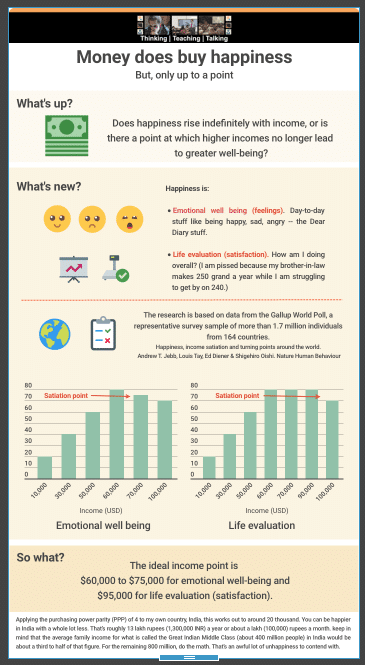Article
OFF THE CUFF: Money does buy happiness but only up to a point
 November 08, 2019
November 08, 2019
We are admonished, ad nauseam, that money can’t buy happiness. This advice has to be high on the list of hypocrisy promoted in aphorisms. As one wag added, “… but you can search for it in comfort.” There is a large body of evidence in support of poor people living less healthy, more depressed and shorter lives than the more affluent. We need money, maybe not in the range of the one percent, but certainly, some reasonable amount. We will have to stop mouthing this banal statement for ever.
Money, by itself, is neither good nor evil. Modern life is not possible without it. We have to come to terms with the reality that a certain amount of money is essential if we are to acquire food, clothing, shelter and personal well being.
Does happiness rise indefinitely with income — is Bezos the happiest man in the world, Bill next and Warren, third — or is there a point at which higher incomes no longer lead to greater well-being — do the one percent often feel like shit?
As always, social scientists are ready to jump in and find the answer to how much money we need to be happy and at what point does the benefit plateau. An article by Andrew T. Jebb, Louis Tay, Ed Diener & Shigehiro Oishi in Nature Human Behaviour gives us some definitive answers.

It appears that there are two elements to happiness.
1. Emotional well-being, or feelings, is about one’s day-to-day emotions, such as feeling happy, excited, or sad and angry — the Dear Diary stuff.
2. Life evaluation (life satisfaction), is an overall assessment of how one is doing and is likely more influenced by higher goals and comparisons to others. Typically, “I am pissed because my loud mouthed brother-in-law makes 250 grand a year while I am struggling to get by on 240.”
The research is based on data from the Gallup World Poll, a representative survey sample of more than 1.7 million individuals from 164 countries. The estimates were averaged based on purchasing power and questions relating to life satisfaction and well-being. For reporting this study, the amounts are reported in U.S. dollars, and the data is per individual.
Globally, the study reported that satiation occurs at $60,000 to $75,000 for emotional well-being and $95,000 for life evaluation.
In certain parts of the world, incomes beyond satiation are associated with lower life evaluations. After the optimal point of needs is met, people may be driven by desires such as pursuing more material gains and engaging in social comparisons, which could, ironically, lower well-being.
So there you go, somewhere between 75 to 90 grand US dollars. Applying the purchasing power parity (PPP) of 4 to my own country, India, this works out to around 20 thousand. You can be happier in India with a whole lot less. That’s roughly 13 lakh rupees (INR) a year or about a lakh of rupees a month. Feels about right, but keep in mind that the average family income for what is called the Great Indian Middle Class (about 400 million people) in India would be about a third to half of that figure. For the remaining 800 million, do the math. That’s an awful lot of unhappiness to contend with.







